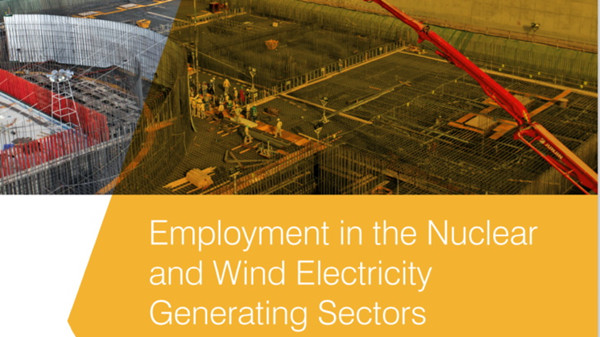Report shows advantages of nuclear employment
The nuclear energy industry provides more numerous, better-paid and more highly-trained jobs than does the wind power sector, according to a technical position paper published today by World Nuclear Association. It provides around 25% more employment per unit of electricity generated.

(Image: World Nuclear Association)
Employment in the Nuclear and Wind Energy Generating Sectors focuses on the job opportunities created by nuclear power plants and provides a comparison with wind, another major source of low-carbon electricity.
Separating employment into several distinct stages - construction, operations and maintenance, and the supply chain - it uses data from existing studies to estimate employment in France and the USA, selected in part on the assumption that the broader supply chain in both those countries is largely nationally based. Direct and indirect employment from the generation of 1000 TWh per year is estimated at 461,000 in the nuclear fleet and 346,000 in wind.
While most sector employment estimates are 'point-in-time', providing a snapshot rather than a view over plant lifetime, the World Nuclear Association paper estimates employment in a 'steady state' for both industries: that is, employment per unit of capacity or of electricity generated in a sector that is neither growing nor contracting and where construction is sufficient only to maintain the size of the current fleet. This enables it to make allowance for the temporarily enlarged labour force employed in planning and construction of a rapidly growing industry - such as wind - against an essentially mature industry, such as nuclear.
The report notes the difficulty of obtaining directly comparable information on the characteristics of the nuclear and wind workforces, but says there is "strong evidence" that nuclear workers are some of the most qualified in the industrial workforce. Nuclear workers also tend live near the plant where they are employed - contributing to local economic development - whereas wind workers are more frequently either temporarily resident (during construction and decommissioning) or live at some distance from the plant, with companies providing maintenance services to a number of windfarms.
Although nuclear generation requires significant investment in employment, it maintains a competitive advantage over intermittent renewables such as wind as it does not require additional investment in backup capacity or storage, the paper notes. "When the total costs of the plant and system are taken into account, nuclear offers not only more local and national job opportunities but also provides cheaper decarbonised electricity than wind," it says.
Researched and written by World Nuclear News
- China Institute of Atomic Energy
- Nuclear Power Institute of China
- Southwestern Institute of Physics
- China Nuclear Power Operation Technology Corporation, Ltd.
- China Nuclear Power Engineering Co., Ltd.
- China Institute for Radiation Protection
- Beijing Research Institute of Uranium Geology (BRIUG)
- China Institute of Nuclear Industry Strategy (CINIS)
- China Nuclear Mining Science and Technology Corporation


